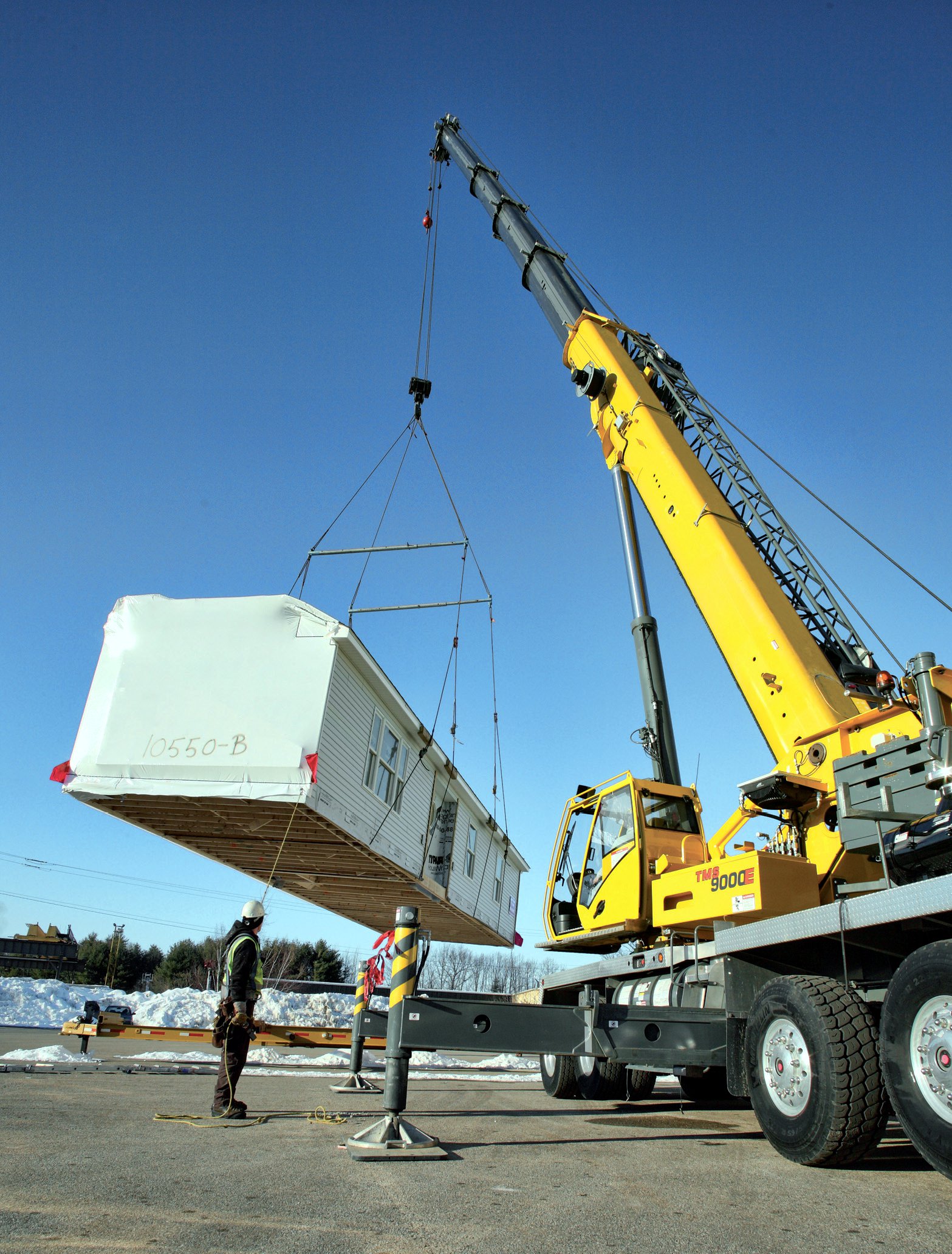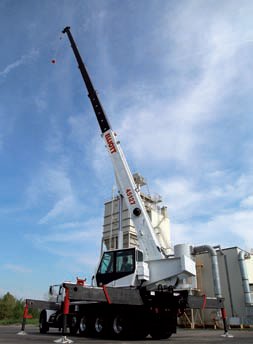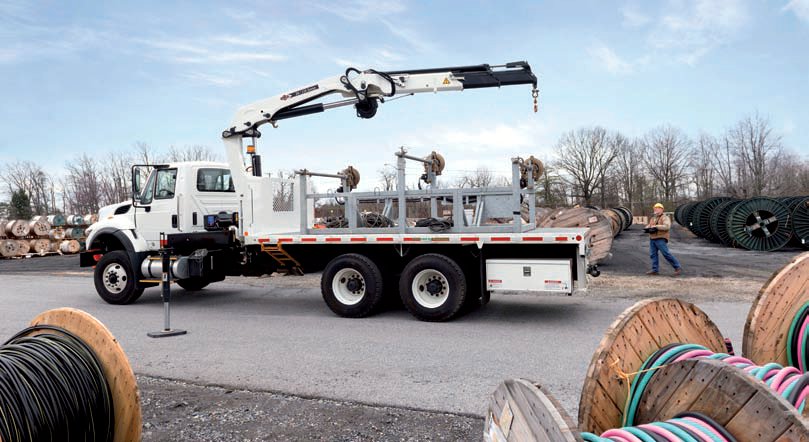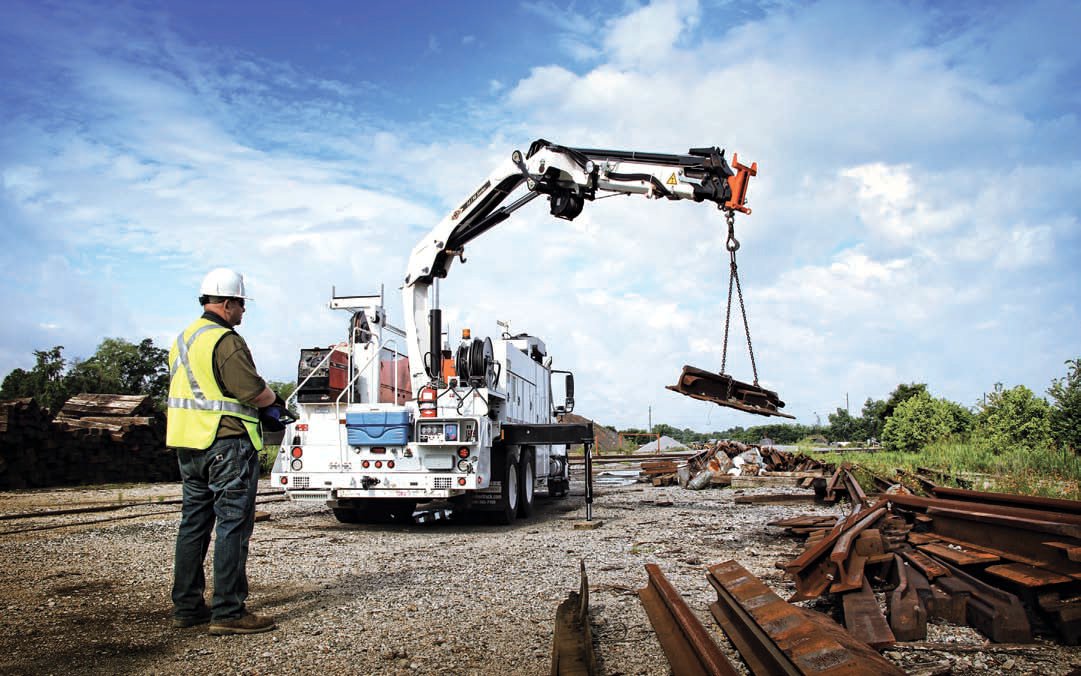King of the road
31 July 2014Particularly popular in North America, truck mounted cranes are versatile low tonnage machines capable of working in a wide range of industries. Recently, the market for these cranes has been expanding with more demand coming from the energy sector. Zak Garner-Purkis looks at what’s making news in this market segment.
From a European perspective, truck mounted cranes are a bit of an unknown quantity compared to the continent's most popular method for multi-purpose low tonnage lifting; the knuckleboom crane. But the truck-mounted crane is a very popular lifting device in North America amongst other regions. Driving the growth of this segment in the US market is the energy sector, and fracking in particular.
The strength of the market is something that manufacturers have seen very clearly in recent months. As David Phillips, head of international sales for manufacturer Elliott, says: "The market for boom trucks is very good right now. We have had strong demand for our products throughout our range. We are seeing strong demand in the oil and utility markets. General construction is also stronger than in recent years. Fracking has increased the demand for cranes in general and longer booms, that can service a wider area with one set-up in particular.
Ruben Olivas, global product director truck cranes and boom trucks at Manitowoc, has also witnessed this strength, although he isn't getting carried away with the success: "Canada and the Gulf Coast of the US have seen a lot of truck crane activity, due to the oil and natural gas industries in those areas. We expect this to continue in 2014. We have also seen some early signs of recovery in the housing industry. It is definitely not at the level of pre- 2008 markets, but there is definitely some activity.
"In other parts of the world, the total figures have been slowing down. In recent years, the Chinese manufacturers gave the total truck crane world market a boost with high volumes of exports. However, those exports have been slowing down and the total global demand for truck cranes has stabilized. There are still a significant number of customers (especially in emerging markets) looking at the initial investment as the sole component when making the decision of purchasing a new truck crane, which makes the Chinese built truck crane attractive; however, in these times, more and more customers in emerging markets are looking at the total picture. They are considering: maintenance costs, downtime, rental rates, re-sale value and more when making a new investment -- thus, protecting their total return on investment."
Versatility
Low tonnage machines have to be versatile. Users are required to perform a vast range of different tasks so having a machine that can handle this is crucial. But, as Phillips explains, balancing these priorities can be a challenge: "We continue to see incremental technical change in our industry. Products today are more refined than they have ever been. Versatility is very important.
Users of Elliott cranes can enjoy multi-functionality, including material lifting, personnel lifting with our DynaSmooth remote controls, and can also dig holes with our optional auger package. We add further versatility in that our products are customizable to the user's exact job requirements."
Manitowoc's Olivas also believes that providing the customer with a machine that can be used for a range of jobs is very important: "Versatility is key. Transport costs are much lower than other types of cranes because most truck mounted cranes are roadable, meaning they don't require special permitting or setup, which keeps costs low for companies operating them. Also, with many truck mounted cranes using commercial truck chassis, it can be easier to find people to perform maintenance or obtain parts for them than other types of cranes. Lifting performance can be enhanced because there is less setup and tear down time, and less preparation time is needed for the crane on the job site. This efficiency results in lower costs; consumables like tyres are more economical than all-terrain tires, manual transmissions more simple, and axle and drive train parts are more economical."
Sometimes providing a bare machine that can be specified for particular jobs can be a good way of ensuring that a crane can be used as a multi-function tool and then modified as an application specific device. Manufacturer Manitex pursues this policy as Randy Robertson, director of sales and marketing, explains: "Several of our major distributors have bare rental fleets of boom trucks and truck mounted cranes. Their successes can be attributed to fitting the machines with factory available options such as personnel basket with radio remote control and oilfield attachments to suit different rental market segments. This affords greater diversity of rental opportunities and increased fleet utilisation."
Technical developments
In every sector of the lifting industry manufacturers are always striving to innovate the machines from a technical perspective. The truck mounted sector is no different with firms constantly trying to come up with new features to win customers in this fiercely contested marketplace. This was definitely what manufacturer IMT sought to do with the introduction of its mid-range articulating cranes. John Field, product manager of material handling at manufacturers IMT, says: "IMT customers need lift and reach capabilities that are tailored to their challenging applications. Our new mid-range articulating crane models offer an elevated level of technology that increases productivity with lower weight that allows for more payload capacity."
Ruben Olivas of Manitowoc has also seen the demand for larger lifting capacities in this market: "Customers desire to have the largest possible crane ready for the road without the need for special permits. In North America there are so many different road regulations that vary from state to state, that as a manufacturer it complicates the design of new products in regards to weight and dimensions. As truck mounted cranes have gotten larger and larger, we have been forced to select five- to six- or more axle trucks, depending where they will be used. Such trucks require special permits anyway, thus entering the "traditional truck crane" world.
"Many truck-mounted cranes above 50USt loose the flexibility and ease of transport of small boom trucks, even if they are mounted on commercially-sourced trucks. As we move forward on finishing the Tier IV final enhancements of our larger truck crane line from the Grove brand, we will have new resources to develop new and exciting products in the coming months and years."
Randy Robertson of Manitex believes that the capacity increase is a technical development is set to run and run: "Our next challenge is how much more crane can you get on a commercial chassis? Manitex is a leader in this arena in the North American market at 63 metric ton and continues to push the envelope."
Fleet replacement
Along with the booming energy sector the North American truck mounted crane market has also been buoyed by a number of firms engaging in fleet replacement. As the financial pressures have eased in the past year many companies particularly small firms invested in new machines, which has benefited the truck mounted crane sector. Changes to emission regulation have also pushed companies to update their fleet.
It's something that Manitex's Robertson has seen: "Manitex is experiencing replacement of older machines. Either because these machines were not replaced during the US recession or because there is a trend or mandated requirement to move into equipment that meet the new emission standards."
That's not to suggest that these machines have short lifespan. Phillips explains these are cranes that can work and work: "The overall boom truck fleet continues to age from its prior cycle peak. Boom trucks are cranes mounted on commercial truck chassis. In general, chassis will last 7-10 years before needing to be retired. Some of the inventory replacement is occurring due to this. Other replacement is occurring due to shifts in demand in the market."
Future
So what's the future for truck mounted cranes of course larger capacities and technical innovations are areas where further development can happen. But there are more ways that manufacturers aim to improve there offerings as Elliot's Phillips explains: "We are constantly looking at ways to help our customers do their work safer and more efficiently, which is why the cost of ownership of our machines is so low. We will continue to explore ways to improve in these areas to deliver maximum value to our users."
Manitowoc's Olivas believes that potential lies in many different areas, such as entering into markets abroad: "When it comes to truck mounted cranes, customers around the world are looking for solutions they can maintain and service locally, and that meet their local standards. As a manufacturer, we have to design products that are easily tailored to those needs. Take the North American NBT45 from National Crane; we have customized that model and named it the GBT35 to meet the needs of different markets around the world, such as Brazil, New Zealand, Australia and South Africa, among others that are mounted on different truck models and styles to meet the local road and crane regulations."
If truck mounted cranes do make an impact on markets beyond North America the potential for the manufacturers is huge. The success of these machines in its 'home' market definitely shows that users are enthusiastic about these cranes. But if the energy sector were to slow or inventory replacement decrease truck crane manufacturers would need to come up with new ways to appeal to customers. These will be the challenges that face the truck mounted crane market in the future.



